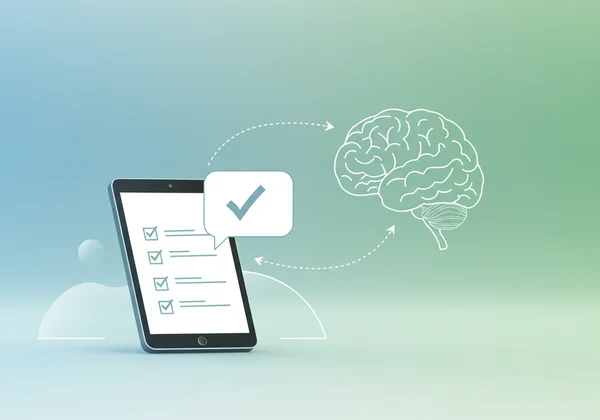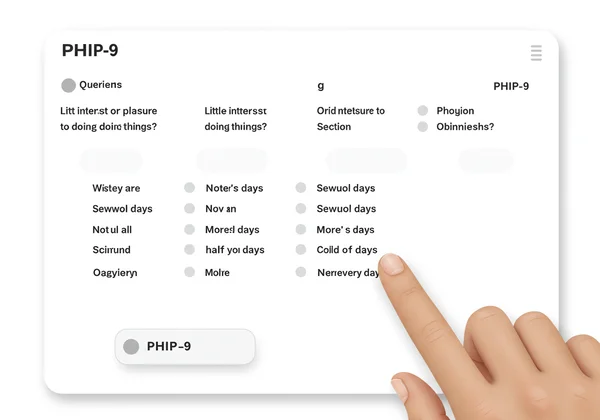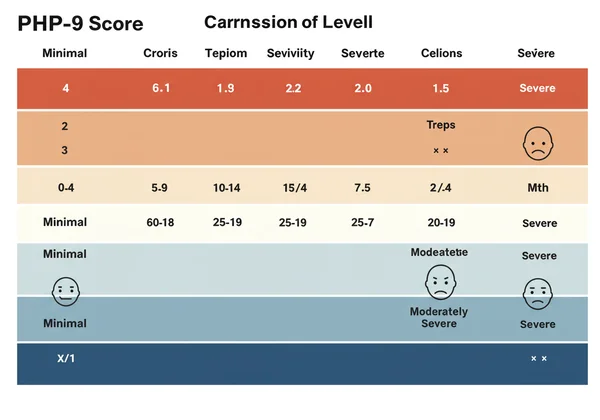PHQ-9 抑郁症筛查:分数意义与解读指南
当感到情绪难以承受时,可能会感到困惑,而看到一份测试分数可能只会带来更多疑问。如果您曾做过 PHQ-9 抑郁症筛查,并疑惑过 “我的抑郁症筛查分数意味着什么?” ——您并非孤例。本指南将揭开患者健康问卷-9 (PHQ-9) 的神秘面纱,这是一个用于抑郁症筛查的可靠工具。了解其计分方式及结果的含义,是迈向清晰认识和改善心理健康的第一步。
迈出第一步往往是最艰难的,但了解自己的情绪状态是一种强大的自我关怀行为。如果您已准备好更好地理解自己的感受,可以在我们的平台上进行抑郁症筛查。我们免费且保密的工具可提供即时结果,帮助您反思自己的情绪健康。
什么是 PHQ-9 抑郁症筛查测试?
PHQ-9 是医疗专业人员最常用于筛查抑郁症的工具之一——您可以将其视为一次初步的心理健康问询。这个简单的九项问卷旨在评估过去两周内抑郁症状的出现和严重程度。它的广泛应用凸显了其在临床环境和研究中的可靠性和有效性。
在我们的平台上,我们的评估建立在 PHQ-9 等成熟科学筛查工具的原则之上。这确保您能获得关于当前情绪状态的可靠且有意义的快照。我们的目标不是给您贴标签,而是为您提供一个自我意识的起点,并在需要时,与专业人士进行沟通。

PHQ-9:标准化的心理健康评估工具
当我们说 PHQ-9 是一个 标准化的心理健康评估工具 时,意味着其问题和计分方式都经过了严格的测试,并且在任何地方都是一致的。这九个问题直接对应了《精神疾病诊断与统计手册》第五版(DSM-5)中概述的重度抑郁症的诊断标准,而 DSM-5 是精神健康专业人员主要使用的手册。这种基于既定标准的根基,使其成为专业评估中值得信赖的第一步。它为您与医疗服务提供者讨论您的症状提供了一个共同的语言。
PHQ-9 问题的结构
PHQ-9 的结构特意设计得简洁明了。这九个问题中的每一个都要求您评估在过去两周内,您被特定问题困扰的频率。这些问题包括抑郁症的核心症状,如情绪低落、失去兴趣或乐趣、睡眠障碍以及食欲或能量水平的变化。
您的回答基于一个四级量表:
- 0 (完全没有)
- 1 (几天)
- 2 (一半以上的时间)
- 3 (几乎每天)
这种基于频率的方法有助于量化您的体验,将其从一种模糊的“情绪低落”的感觉,转变为对您日常功能的更具体描述。这种清晰度对于个人反思和专业咨询都非常有帮助。您可以立即开始您的评估,看看这些问题如何应用于您的经历。

解读您的 PHQ-9 分数:它意味着什么?
完成问卷后,您的答案会被汇总,得出一个介于 0 到 27 之间的总分数。这个数字提供了 PHQ9 分数意义 的度量,并有助于对抑郁症状的严重程度进行分类。重要的是要记住,这个分数是一个时间快照——反映的是过去两周的情况,而不是一个永久的标签。
了解您的分数可以减轻焦虑,并为您带来知识上的力量。它将抽象的感觉转化为更具体的东西,您可以对其进行监控和处理。我们免费在线抑郁症测试会立即为您提供分数摘要,让您可以立即开始这个理解过程。
理解 PHQ-9 分数范围:从轻微到严重抑郁
PHQ-9 的总分数分为几个类别,表明了不同程度的 症状严重性。虽然解读可能略有差异,但普遍接受的范围是:
-
0-4:轻微或无抑郁。 您的分数表明您几乎没有或根本没有经历抑郁症状。这是心理健康的一个很好的基线。
-
5-9:轻度抑郁。 您可能正在经历一些持续的、低级别的症状,这些症状令人烦恼,但可能不会严重影响您的日常功能。这是一个关注自我护理和监测感受的好时机。
-
10-14:中度抑郁。 在这个水平上,抑郁症状很可能已经干扰了您的日常生活,包括工作、学习或人际关系。通常建议进行专业咨询。
-
15-19:中重度抑郁。 症状频繁出现,并严重影响您的日常生活。强烈建议寻求专业帮助。
-
20-27:重度抑郁。 您的症状普遍存在,并严重影响您的功能。在此阶段,寻求医生或心理健康专业人士的帮助至关重要。

数字之外:您的分数对您的健康状况有何指示?
您的分数是一个有用的指标,但它并不能完全反映您的 情绪健康。两个得分相同的人可能有截然不同的经历。例如,一个人可能因为睡眠和食欲问题而得分很高,而另一个人可能更受无价值感和情绪低落的困扰。因此,重要的是要超越分数本身,并考虑这些症状如何影响您的独特生活。
这就是更详细分析的价值所在。在从测试中获得初步分数后,您可以选择回答更多问题,以解锁由人工智能驱动的个性化报告。这份报告将提供您个人优势、挑战以及您的症状如何影响您生活特定方面的更深入见解,并附带可操作的后续步骤。发现您的结果并获得更全面的了解。
抑郁症筛查测试后的重要注意事项
收到您的分数仅仅是开始。这些信息是一个工具,就像任何工具一样,只有正确使用才能发挥最大效用。抑郁症筛查测试 的结果旨在指导和赋能您,而不是引起恐慌。最重要的下一步是正确地将结果置于适当的背景下,并决定如何处理您获得的信息。
PHQ-9 是筛查工具,而非医疗诊断
至关重要的是要记住 筛查工具,如 PHQ-9,并非医疗诊断。这些工具用于识别可能面临抑郁风险并可能受益于进一步评估的个体。只有合格的医疗保健提供者——例如医生、精神科医生或心理学家——才能做出正式诊断。
专业评估包括对您的症状、病史和生活状况进行全面讨论。虽然您的测试分数是您在就诊时带来的宝贵信息,但它不能替代专业人士的临床判断。
何时寻求专业帮助
了解何时寻求专业支持是管理心理健康的关键部分。通常,如果您出现以下情况,最好咨询医疗保健提供者:
- 您的分数属于中度至重度范围(10 分或以上)。
- 您的症状持续时间超过两周。
- 您的情绪严重干扰了您的工作、人际关系或享受生活的能力。
- 您有任何伤害自己的想法。
与医生交谈是勇敢且积极的一步。他们可以帮助您理解自己的症状,讨论治疗方案,并引导您走向更健康的心态。

理解您情绪健康的下一步
理解您的 PHQ-9 分数是自我发现和健康管理旅程中的一个绝佳起点。它为您提供了一个清晰、基于循证的起点,以帮助您理解自己的感受。请记住,这个分数不是最终判决,而是帮助您更清晰地认识和应对情绪状态的指南。
通往情绪健康的道路始于知识。既然您了解了 PHQ-9,您就能更好地采取有意义的行动。一个绝佳的下一步是进行一次保密的筛查,以了解您自己的基线。访问 DepressionTest.co 使用我们免费的、基于科学的工具。您将收到即时摘要,并可以选择解锁更深入的人工智能驱动报告,以指导您的后续步骤。
关于抑郁症筛查测试的常见问题
什么是抑郁症筛查测试?
抑郁症筛查测试 是一种用于识别潜在抑郁症状的问卷。它是一个快速的初步工具——而非诊断——它有助于确定是否需要医疗保健专业人士进行更彻底的评估。PHQ-9 等工具经过科学验证,可以提供关于您近期情绪状态的可靠快照。
我的抑郁症测试分数意味着什么?
您的 抑郁症测试分数 表明了您近期经历的抑郁症状的严重程度。分数通常会分为轻微、轻度、中度或重度等类别。这有助于您了解其对您的身心健康的潜在影响,并作为与医生交流或制定个人自我护理计划的起点。您可以在我们的网站上免费获取您的分数。
我如何检查我是否患有抑郁症?
检查您是否可能患有抑郁症的一个可靠方法是使用标准化的筛查工具,例如我们基于 PHQ-9 模型设计的在线抑郁症测试。它提供了对您症状的客观衡量。然而,要获得明确的答案和诊断,咨询能够进行全面评估的医疗保健专业人士至关重要。
我是抑郁了还是只是悲伤?
悲伤是一种正常的、时有时无的人类情绪,而抑郁症是一种以持续且弥漫性的情绪低落、失去兴趣以及其他影响日常生活的症状为特征的医学状况。一个关键的区别在于持续时间和影响。如果悲伤的感觉持续两周以上,并且严重影响了您的功能能力,那可能不仅仅是悲伤。进行一次快速抑郁症测试可以帮助您澄清这些感受。
免责声明:本文仅供参考,不构成医疗建议。此处提供的筛查工具并非诊断工具。如有任何健康问题或在做出任何与健康相关的决定之前,请咨询合格的医疗保健专业人士。如果您正处于危机之中,请立即联系当地的紧急号码或危机热线。